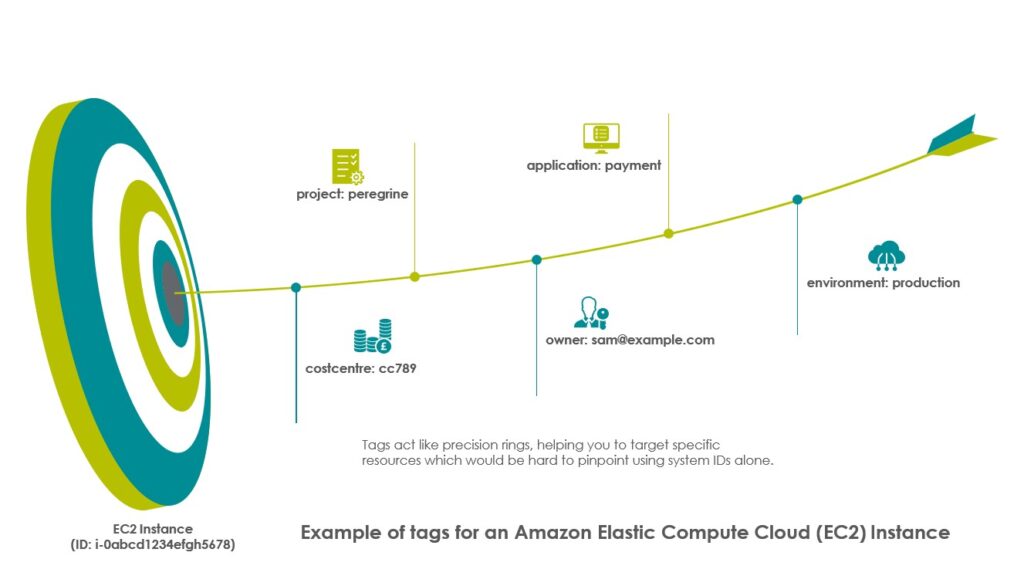From chaos to clarity: organising your cloud with tagging

key fact
Effective cloud tagging brings structure, enabling better cost control, governance, security, and operational efficiency across increasingly complex cloud environments.
Imagine moving into a new house. You are surrounded by a mountain of unlabelled boxes; some marked vaguely with “stuff” or “miscellaneous.” You know your essentials are in there somewhere, but finding your coffee mugs or laptop charger suddenly feels like a scavenger hunt. Now, contrast that with a move where every box is clearly labelled; “Kitchen: Plates,” “Living Room: Books,” “Office: Cables.” Everything has its place, and unpacking becomes effortless.
Managing cloud resources isn’t much different.
Without a system of clear labels (known as “tags” in the cloud world), it’s like unpacking a house full of unlabelled boxes; you spend more time searching than settling. In today’s fast-paced digital environment, where cloud resources multiply rapidly across teams and departments, a lack of structure can lead to cost overruns, compliance issues, and operational confusion.
What is cloud tagging?
Cloud tagging refers to the practice of assigning descriptive metadata to cloud resources. It consists of two components: a key and a value, which are used to identify and categorise a resource within a cloud ecosystem (e.g. environment: production). Hyperscalers such as Microsoft Azure, AWS and Google Cloud provide tagging as a standard feature. When used effectively, tagging transforms abstract, technical assets into identifiable and manageable entities.

Why tagging matters
As your cloud footprint grows, so does the complexity of managing it. What started as a handful of resources can quickly turn into thousands spread across teams, environments, and regions. Without a clear and consistent tagging strategy visibility fades, accountability slips, and inefficiencies creep in. When tagging is done well, it unlocks real business value across multiple areas:
- Financial clarity: tags provide the insight finance teams need to track spending accurately and spot opportunities to cut costs. This means budgets are smarter and resources aren’t wasted.
- Streamlined operations: clear tagging simplifies how teams locate and manage resources, speeding up workflows and reducing errors. It lays the groundwork for automation that saves time and effort.
- Stronger security and governance: by tagging critical assets and their locations, organisations can better enforce policies and spot compliance gaps before they become problems. It also eases the burden of audits.
- Clear ownership: when tags identify who’s responsible for each resource, it avoids confusion and orphaned assets. Teams know exactly who to contact if issues arise, which speeds up resolution.
That said, getting tagging right isn’t always easy. Here are some of the common challenges organisations run into:
- Many cloud resources don’t have any tags at all, which makes it difficult to manage and track them effectively.
- Even when tagged, resources often lack detail; most have a single tag, missing key data for visibility, automation, and cost tracking. This leads to wasted time, duplication risks, and unclear ownership during incidents or changes.
- Tagging often stops at the surface. Many cloud resources, like EC2 instances with nineteen taggable sub-components, are incompletely tagged overlooking key details that should be included for effective management, visibility, and accountability.
- Lack of clarity; it’s not unusual to find duplicate, inconsistent, or misspelt tag keys scattered across an environment. This kind of inconsistency not only creates confusion but also undermines the value of having a tagging system in the first place.
The good news? A well-thought-out tagging strategy can solve a lot of these issues. It brings structure to the chaos, helping teams gain visibility into what they are running, hold the right people accountable, and make more informed decisions across finance, security, and operations.
Tagging isn’t just an admin task; it’s foundational to doing cloud properly.
Tagging strategies: where to start?
Before tagging, understand its purpose. Many organisations start without a clear plan. Are you tagging for billing, access, auditing, automation, compliance or all of these? Your strategy should align with business goals. If aiming for cloud cost visibility, tags should support that, breaking costs down by team, unit, or client. Tagging then becomes a tool for insight, not just admin. Set clear goals first to guide everything else.
Bringing everyone to the table
Tagging isn’t just for tech teams. It affects everyone, from application owners and IT finance to security, operations, and business leads. Each has different needs: finance wants cost clarity, security needs compliance, application teams seek performance. Without alignment, tagging gets messy. The key is early collaboration on a shared framework that reflects all views. It’s not added complexity just smart, inclusive planning that ensures tagging works.
Keep names consistent. It really matters
It might seem like a small detail, but naming conventions can make or break your tagging strategy. If one team uses “environment: production”, another “environment: prod”, and a third just goes with “env: PRD”, your reporting is going to get messy fast. Agree on consistent key-value pairs from the start, same spellings, capitalisation and formatting. It makes automation smoother, avoids confusion, and keeps everything tidy across the board.
Decide what’s a must have vs nice to have
Not all tags are created equal. Some are essential like identifying who owns a resource or which environment it belongs to. Others might just be helpful context. The trick is knowing which tags are mandatory and which ones can be optional. Make those must have tags part of your standard process and enforce them where you can. That way, critical data is always captured, and teams still have the flexibility to add extra detail when it’s useful.
Think ahead. Build for growth
Tagging strategies often fall apart when businesses scale. What worked for a few teams or apps might not hold up as things grow. That’s why long-term thinking matters. Plan a flexible, future-proof framework that can support new teams, clients, or new Hyperscalers each with its own tagging rules. It’s all about building a structure that grows with you, not against you.
Establish a clear tagging policy
A well-defined tagging policy sets out who is responsible for tagging, how it’s enforced, and which tools support the process. Treat it as a living document accessible, easy to understand, and regularly updated to reflect evolving needs. With shared responsibility and clear guidance, tagging remains effective, scalable, and aligned with governance and reporting requirements.
Move beyond setting rules. Ensure they’re followed
A tagging policy is only valuable if it’s actively applied. Without proper governance, things can quickly unravel. Define how tags should be used and put mechanisms in place to ensure compliance be it automation, periodic audits, or deployment checklists. The aim isn’t to create barriers but to maintain consistency and reliability.
Be security conscious with what you tag
Tags may seem harmless, but they can unintentionally expose sensitive information such as client names, internal codes, or project details. Be mindful of what’s included and where it appears. Limit visibility and editing rights to the appropriate users and avoid placing confidential data in publicly accessible metadata fields.
Keep it manageable. Simplicity is key
While it might be tempting to tag everything, too many tags can cause confusion and lead to misuse. Focus on what’s truly beneficial those that enhance visibility, control, or automation. A streamlined, purposeful tagging structure will always outperform a cluttered, underused one.
Make it understandable and worth embracing
For a tagging strategy to succeed, everyone needs to understand it. Provide clear, concise documentation outlining available tags, their purpose, and when to apply them. Support this with training, best practice sharing, and team onboarding. When people grasp the value behind tagging, they’re far more likely to follow it.
Conclusion
Cloud tagging might seem small, but it packs a serious punch. It helps finance teams stay on top of budgets, flags sensitive systems for security, and keeps automation humming. Not sure who owns it or what it’s for? Tags have your back. And when it comes to governance and reporting, they make insights easy and policies stick. Bottom line? Tag smart, and your whole team wins.
If you would like to speak to Shaheen regarding this insight, send your enquiry to contact@masonadvisory.com
If you want to find out more about our services, click here.